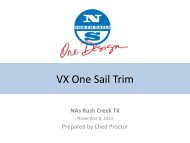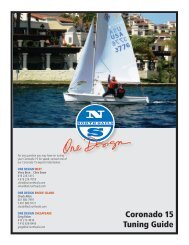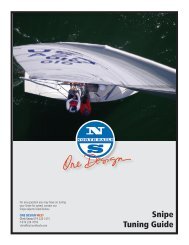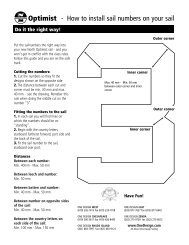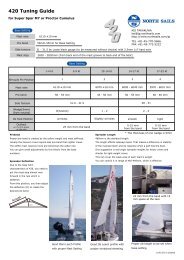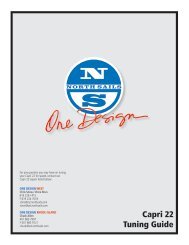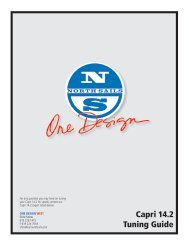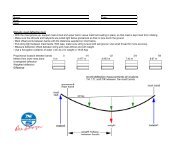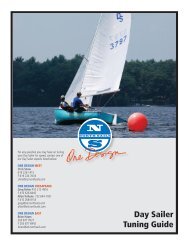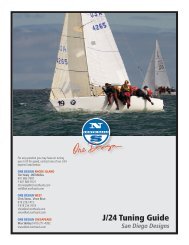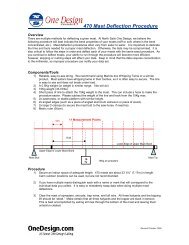Sonar Tuning Guide - North Sails - One Design
Sonar Tuning Guide - North Sails - One Design
Sonar Tuning Guide - North Sails - One Design
- No tags were found...
Create successful ePaper yourself
Turn your PDF publications into a flip-book with our unique Google optimized e-Paper software.
For any question you may have on tuningyour <strong>Sonar</strong> for speed, contact our<strong>Sonar</strong> experts listed below:ONE DESIGN EASTChed Proctor . Brian Hayes203 877 7627F 203 877 6942ched@od.northsails.combrian@od.northsails.comONE DESIGN ZENDAAndy Burdick . Harry Melges262 275 9728 F 262 275 8012andy@melges.comONE DESIGN RHODE ISLANDChuck Allen . Will Welles401 683 7997F 401 683 9121chuck@od.northsails.comwillw@sales.northsails.com<strong>Sonar</strong><strong>Tuning</strong> <strong>Guide</strong>
NORTH SAILS<strong>Sonar</strong><strong>Tuning</strong> <strong>Guide</strong>This comprehensive tuning guide will giveyou the key information needed to stayin the front of the <strong>Sonar</strong> Fleet whetheryou are sailing at the local or nationallevel. Our sails are designed with proventechnology in cloth as well as shape toinsure durability and speed on the racecourse. Our sails are also designed tokeep things simple in order to give you theconfidence that is needed to keep yourhead out of the boat while sailing in close<strong>One</strong> <strong>Design</strong> competition.Tools Needed- 50 Foot Tape Measure- Shims (At mast partners)- Electrical Tape- Silicon- Screw Driver- Level- Mast Blocks (six 1/2" blocks)- Indelible Marker- Adjustable Wrench- Model “A” Loos gaugeBefore Stepping the Mast1. Forestay should be 25' 11" whenmeasured from the bearing point ofthe Tee fitting aloft to the center of theturnbuckle clevis pin.2. Clean and lubricate turnbuckles.3. Spreader angle: set deflection at 2 3/4-- 3".**To get proper deflection measure fromthe back face of the mast to a line extendingbetween the holes in the spreader tips. Thisdistance should be 2 3/4 -- 3".After Stepping the Mast1. Adjust partner to fit snugly side to side(so mast is centered.)2. Mast step: Measure the distance fromthe aft face of the mast where it meets thestep casting to the gel-coat edge of thecenter of the cabin opening lip near thefloor. This should be set between 28 1/4"and 28 3/4". (Ontario boats only.)3. Next, measure the distance from theforward edge of the mast partner openingto the center of the headstay anchorpoint. The class rule limits this dance to 7'-11.5".Fine <strong>Tuning</strong> the Rig1. Center the mast laterally using a tapemeasure on the jib halyard to a commonspot on the port and starboard rails.2. Remove any mast blocks as well as thelower shrouds from the chainplates.3. Remove the slack from the backstayuntil the headstay just becomes taut (nomast bend.) Place a mark on the deckabeam of the aft face of the mast. This isyour reference point in the relaxed state.4. Now pre-bend your mast at the deckwith mast blocks on the aft side until youhave moved the mast 1" forward of themark. Make a new mark and erase theold. This is the new "Neutral" position.5. Next, you want to tension your uppershrouds in equal increments on bothsides to between 230-260 pounds usinga "LOOS-Model A" tension gauge (cablesize is 5/32" or equivalent.) Check themast laterally again by repeating step #l.6. Finally you want to attach the lowershrouds and adjust them so that youcan make 8 to 10” circles with them atshoulder height. This requires some guesswork but loose lowers are required tokeep the tip of the mast in column whenyou are sailing. Minor adjustments shouldbe made to you're lowers when you firstgo sailing by sighting up the mast trackand tightening or loosening the lowersto keep the rig straight. Now you have agreat starting point and adjustments willbe made from and relative to this positiondepending on different wind strengths andsea conditions.Trimming Your <strong>Sails</strong>It's important to mark all your shrouds,sheets, tracks, outhaul, backstay, etc. Keeprecords of your tuning set-ups for differentconditions in order to be able to reproducesettings when you know the boat wasgoing fast.BlockingYou want to make six 1/2" wide plasticblocks from the template shown below,this will give you the proper amount ofblocks to take up the extra space andallow you to block the mast according toour chart. **Blocking measured fromaft face of mast relative to the neutralposition.Visit our web site at www.<strong>One</strong><strong>Design</strong>.com for the latest <strong>Sonar</strong> news and tuning tips.© 2007 <strong>North</strong> <strong>Sails</strong> <strong>One</strong> <strong>Design</strong>. All rights reserved.1
NORTH SAILS<strong>Sonar</strong><strong>Tuning</strong> <strong>Guide</strong>Blocking Positions:Light Air/Flat Water: 1" in front of neutralLight Air/Lump:1/2"in front of neutralMedium Air/Flat Water: NeutralMedium Air / Lump: NeutralHeavy Air/Flat Water: 1/2" behind neutralHeavy Air/Lump: 1" behind neutralMast blocking has two profound effects.First, the more blocks you put behindthe mast the less headstay tension youwill have and the more the headstay willsag. This results in a deeper and morepowerful jib for light and lumpy conditions.Secondly, blocking in front of the mastwill create more headstay tension thus aflatter jib for windy conditions. The secondeffect is relative draft position of the lowerpart of the main. In lighter air blockingto induce pre-bend (behind the mast), willremove forward draft and decrease thedepth of the sail. In heavy conditions, youwill want to block in front of the mast inorder to power up the bottom part of themain in order to help you through rougherseas. Remember blocking in front alsogive you more tension on the headstay fora flatter jib.MainsailTrim the mainsheet hard enough to makethe top batten parallel to the boom.You can check this by sighting fromunderneath the boom on a vertical plane.Once the boat has accelerated and youwant to point higher, trim harder (2-3")to cock the top batten slightly to weather.If the mainsheet is too tight (evidence bytop batten hooking to weather), you willslow down. In light air and choppy water,the top batten should be parallel or twistoff slightly. You may want to mark yourmainsheet somewhere in the middle soyou have a nice reference point for markroundings and upwind sailing. Pull thetraveler car to windward until the boomis on centerline. To check this, have yourcrew sight aft along the boom and line upthe center of the boom with the eye thatattaches the backstay to boat (this shouldbe in the center of the transom). Keep theboom on centerline up to 12 knots andgradually drop the traveler to keep helmand heeling under control as wind speedincreases. The lens foot allows the sailto act as a loose-footed sail. Upwind thelens foot should not be fully open. To setyour outhaul properly, use the followingguide:**This chart is based on settings relativeto the black bandKNOTSOUTHAULTENSION0-5 Eased 1 1/2"6-10 Eased 1”11-14 Eased 1/2"15+ Maximum**On reaches and runs the outhaul iseased 1 - 2".The cunningham is used to position thedraft in the main. Your goal should beto keep the maximum draft position50% back in the sail or just slightlyforward of this. In a new sail, we useno cunningham up to 6 knots, enoughto remove most of the wrinkles in 7 - 14knots and progressively tighter in higherwinds so there are no wrinkles. Pull thecunningham very hard above 18 knotsto move the draft forward in the top ofthe sail. Under most circumstances, youdo not need much backstay tension.The exception would be in breezy,extremely puffy conditions, particularlywhen combined with flat water. In theseconditions, you can use the backstay asa power control. Pulling the backstayreduces the power in the mainsail up highby opening the leech, thus reducing heeland weather helm. Remember, backstayhas a large effect on luff sag. A tighterbackstay equals less luff sag. More luffsag makes the jib entry fuller and movesthe point of maximum draft back. Thisis best in light air and flat water. Asthe breeze freshens, a straighter jib luffproduces a flatter jib entry. Use the boomvang downwind and on the reachesto control the amount of twist in themainsail. The twist should be the leastamount that still permits attached flowat the upper batten telltale and stalling isunavoidable. From 100 degrees or so toa dead run set, the vang so the top battenis parallel to the boom. Your main sail isequipped with a leech cord. The primaryfunction of the leech cord is to prevent theleech from fluttering. In windy conditions,tension the leech cord to prevent theleech from fluttering. In light to moderateconditions, pull it just tight enough toeliminate flutter.JibYour <strong>North</strong> <strong>Sonar</strong> jib does not have awire in it. Therefore, luff sag is controlledby headstay tension (see blocking andbackstay section of tuning guide). Luff sagVisit our web site at www.<strong>One</strong><strong>Design</strong>.com for the latest <strong>Sonar</strong> news and tuning tips.© 2007 <strong>North</strong> <strong>Sails</strong> <strong>One</strong> <strong>Design</strong>. All rights reserved.2
NORTH SAILS<strong>Sonar</strong><strong>Tuning</strong> <strong>Guide</strong>is measured as an offset from the centerof the jib luff to a straight line betweenthe head and tack of the jib. To trim thejib correctly, you must have the lead inthe proper fore and aft position. This isaccomplished by moving the lead forwardor backwards until all three telltales onyour jib lift at the same time as you beginto pinch the boat above a close hauledcourse. If you find that the windwardtelltale on the top of the sail lifts beforethe ones lower down, this is an indicationthat the lead is so far aft and should bemoved forward. Conversely, should thewindward telltale on the bottom of the saillift before those higher, then you shouldmove the lead aft. After experimentingin say 8 to 12 knots and you have yourcentral lead position, you may want tomove the lead forward a little in very lightair and aft a bit when the breeze is above15 knots. The most critical adjustmentyou will make with your jib is the sheettension. The best way to gauge this isto pull the sheet is when you are goingupwind until the upper batten is parallelto the center line of the boat at the backend, or perhaps points just to leewardfrom parallel. In no instance do you wantthe upper batten pointing to windwardtowards the mainsail. This will createbackwinding and stall the boat which willslow you down.Spinnaker and DownwindSailingSet the vang so the top batten is parallelto the boom. Ease cunningham, outhauland backstay. Trim the spinnaker so thereis 6" to 8" of curl in the luff. Keep poleperpendicular to apparent wind. Keepoutboard end of the pole even with thefree clew. On runs you may want touse some leeward tweeker to keep theleeward leech from opening too much.**Remember, over trimming the spinnaker(never allowing the luff to curl) chokesdown the slot between spinnaker, leech,and main. The result is a boat drivensideways instead of forward.Steering TechniqueThe <strong>Sonar</strong> has a very big main, therefore,it is very important to balance the boat fordifferent wind strengths. If your boat isnot balanced, you will feel it in the helm.In heavy conditions you want to de-powerthe main in order to reduce windwardhelm. Since hiking is limited in the <strong>Sonar</strong>class, it is a good idea to sail with fourpeople, you can use these people to youradvantage by moving them around in theboat. Use crew weight to help steer theboat upwind as well as downwind. Inlight air, keep the crew weight low andforward in the boat as the wind freshensmoves the crew weight to the windwardrail and forward and close together. In allconditions playing the mainsheet, travelerand backstay will keep you in close tunewith the helm. Remember, steering fast isa function of concentration and balance ofyour boat.This tuning guide has provided thenumbers and know-how to balanceyour boat. Now it is time to get out andpractice and enjoy the upcoming racingseason.Sail CareYour new main and jib are made from stiffresinated cloth. With just a little extracare, they will perform at top speed longerthan softer materials. Both main and jibcome in tube bags. They should be rolledstarting at the head straight down theleech so that the battens remain parallel.The spinnaker should be flaked so thatthe leech tapes do not get wrinkled. Thespinnaker should not be stored wet forlong periods of time -- some bleeding ofcolors may occur and this is not covered bywarranty. All sails should be rinsedperiodically to remove salt and should bedry when rolled up. Diligence in theseareas will dramatically extend the life ofyour sails.Contact <strong>North</strong> <strong>Sails</strong>For tuning information and completedetails on how to setup your <strong>Sonar</strong> sailscontact the <strong>North</strong> <strong>Sonar</strong> experts listed onthe cover of this guide.Good Sailing!Visit our web site at www.<strong>One</strong><strong>Design</strong>.com for the latest <strong>Sonar</strong> news and tuning tips.© 2007 <strong>North</strong> <strong>Sails</strong> <strong>One</strong> <strong>Design</strong>. All rights reserved.3
NORTH SAILS<strong>Sonar</strong><strong>Tuning</strong> <strong>Guide</strong>NORTH SAILS ONE DESIGNQUALITY CONTROL CHECK<strong>Sonar</strong>MAINSAIL JIB SPINNAKERCorners Corners CornersCunningham Battens Numbers (black only)A001 near headboard on luff rope Luff Tabs Country Code (black only)Tack slug Telltales VelcroRoyalty (signed) Leech telltales RoyaltyNumbers (black only) Leech Chord <strong>North</strong> LogoCountry Code (black only) Trim Chord BagBattensLeech TelltalesLeech LineInsignia<strong>North</strong> LogoBagFoot ChordTrim stripeRoyalty<strong>North</strong> LogoBagChecked by: ___________________Date: ____ / ____ / ____Visit our web site at www.<strong>One</strong><strong>Design</strong>.com for the latest <strong>Sonar</strong> news and tuning tips.© 2007 <strong>North</strong> <strong>Sails</strong> <strong>One</strong> <strong>Design</strong>. All rights reserved.4



